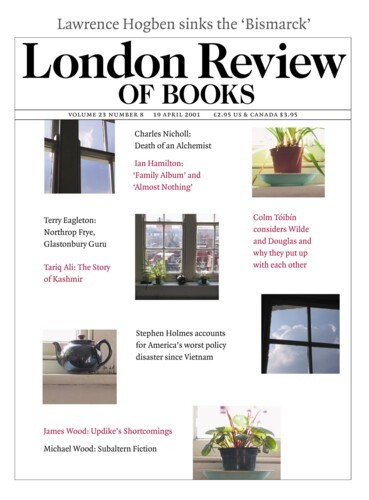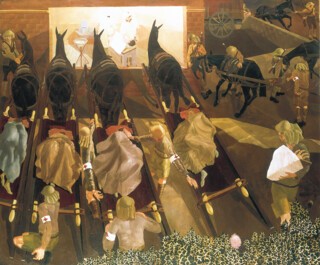Official art has a bad name, yet the pictures commissioned in Britain to record the two world wars were often as good, or better, than anything else the artists did. The paintings Stanley Spencer based on his memories of service in the First War – represented in the exhibition at Tate Britain by his picture of a field dressing station in Salonika – and those commissioned in 1940 showing shipyard workers are not just the-thing-I-wanted-to-do-anyway given a public outing, but art successfully attending on, or at least consonant with, public feeling.
When approached as a potential War Artist Spencer suggested a Crucifixion in homage to the sufferings of Poland. The cautious commissioners rejected that, but let him have a go at shipbuilding. They were right to prefer him in that vein. The welders and cutters, each lit by his torch, are knitted into compositions in which a purposeful confusion of cut steel sets up a geometry which is counterpointed by the figures – men crouching in odd, work-induced poses. These pictures, monumental in organisation and mundane in detail, are proper tributes to the effort of everyday life.
It was twenty years earlier, in 1919, that he painted Travoys with Wounded Soldiers Arriving at a Dressing Station at Smol, Macedonia, 1919. This, too, was something he had seen. Writing in 1923 to Hilda Carline – who would become his wife – he described how the casualties were dragged along: ‘there were travoys and limbers crammed full of wounded men. One would have thought that the scene was a sordid one, a terrible scene . . . but I felt there was a grandeur.’ Which is what his picture has, although like Swan Upping, also finished in 1919, it depends for its effectiveness on decorative distortions that take it closer to poster art – the kind of thing London Transport would later commission – than to the more radical transformations Bomberg and others were experimenting with. They could concern themselves with where art was going. Spencer had too much else on his mind: he had things to say – painting was the good-enough medium, not an end in itself. The Macedonia picture went down well at the time, as it deserved to do.
The recalcitrant mules in the upper right corner suggest real memories of how the animals looked. As time passes Spencer does not dig back in quite that way. He either paints what is in front of him, or what he remembers feeling, not what he remembers seeing. In the first category are the quick-selling pot-boilers – mostly of scenes around Cookham – which he turned out to make money in the 1930s. But also the nude double portraits of himself and Patricia Preece. Timothy Hyman’s catalogue essay (both his essay and Patrick Wright’s add a great deal to the exhibition’s success) is marked by an ability to sort out the seriously impressive and the absurd in Spencer’s work, without failing to see the absurdity of some of the seriousness and vice versa. He is surely right to reckon that the Leg of Mutton Nude has a ‘psychological charge few other British paintings have ever rivalled’, and to point out later that there is something missing when you come to look at the paint.
Seen close-up, anything Stanley Spencer did – the Resurrection, his own naked body, an unpicturesque Cookham front garden or a bunch of flowers – shows the same kinds of mark, neatly made with a smallish brush. There are neither broad strokes nor finicky details. The paintings were completed area by area, not stage by stage. The unfinished Christ Preaching at Cookham Regatta shows how he worked – finishing one patch at a time, filling in a single figure or piece of background – like an embroiderer or a fresco-painter. This way of doing things – a sort of painting by numbers in which all areas are given equal attention – leads not only to a dead surface, but to an equality of light over the whole picture. There are no large areas of shadow, no sudden shafts of sunlight. A plant, a ladder or a leg has its own shadows and highlights, but the picture as a whole has a tapestry-like evenness in which pattern and texture dominate – florals and checks, brickwork, the folds of trousers, a herring-bone jacket, the leaves on trees, the stones on the ground. You never quite know where the light is coming from or where your eye should first rest.
In 1927 Spencer began work on the memorial chapel at Burghclere: the most impressively sustained piece of mural decoration carried out in England at that time or at any time since. There he used his own experience as the basis for scenes which read as commentaries on the general experience of war. When it was finished in 1932 he returned to Cookham with another architectural project in mind, one which would have been an even more radical mix of the personal and the universal: a ‘Church of Me’. What he wanted to do was gather up and make sense of most of what he had painted up to that point and would paint in the future: religious pictures and autobiographical ones would have their rooms and chapels – there would, for example, be one dedicated to each of his wives, with one of the nude double portraits as the altarpiece in the Patricia room.
Love, he was sure, was all: God’s love, Stanley’s love, sexual love. The coming together of all human and animal congregations in a spiritual love-feast was a prelude to salvation. The men and women in the paintings done during the 1930s which would have had their place on the walls of the Church of Me (there is a computer-generated version of its linked rooms in the exhibition – well worth the five minutes the video takes to run) are odder even than his earlier oddities. They are more disjointed, their limbs more floppy, and their faces more like potatoes. Spencer said these were loving caricatures, that physical imperfections (and who says what is perfect?) should be no barrier to loving and coupling. The Church of Me is just one example of Spencer’s self-absorption. It protected him from ‘the tame formalistic orthodoxy which was Roger Fry’s enduring legacy to British art’ (Hyman’s comment on Fry’s dismissal of Spencer). It also made him uninterested in the physical qualities of painted canvas. His achievement was a very English thing which it is easier to make sense of in terms of a literary tradition – the writing of T.F. Powys, for example – than a visual one. Much of his work is hard to like and most of it equally hard to forget.
The exhibition runs until 24 June; the catalogue is published by the Tate (264 pp., £29.99, 22 March, 1 85437 377 3).
Send Letters To:
The Editor
London Review of Books,
28 Little Russell Street
London, WC1A 2HN
letters@lrb.co.uk
Please include name, address, and a telephone number.


